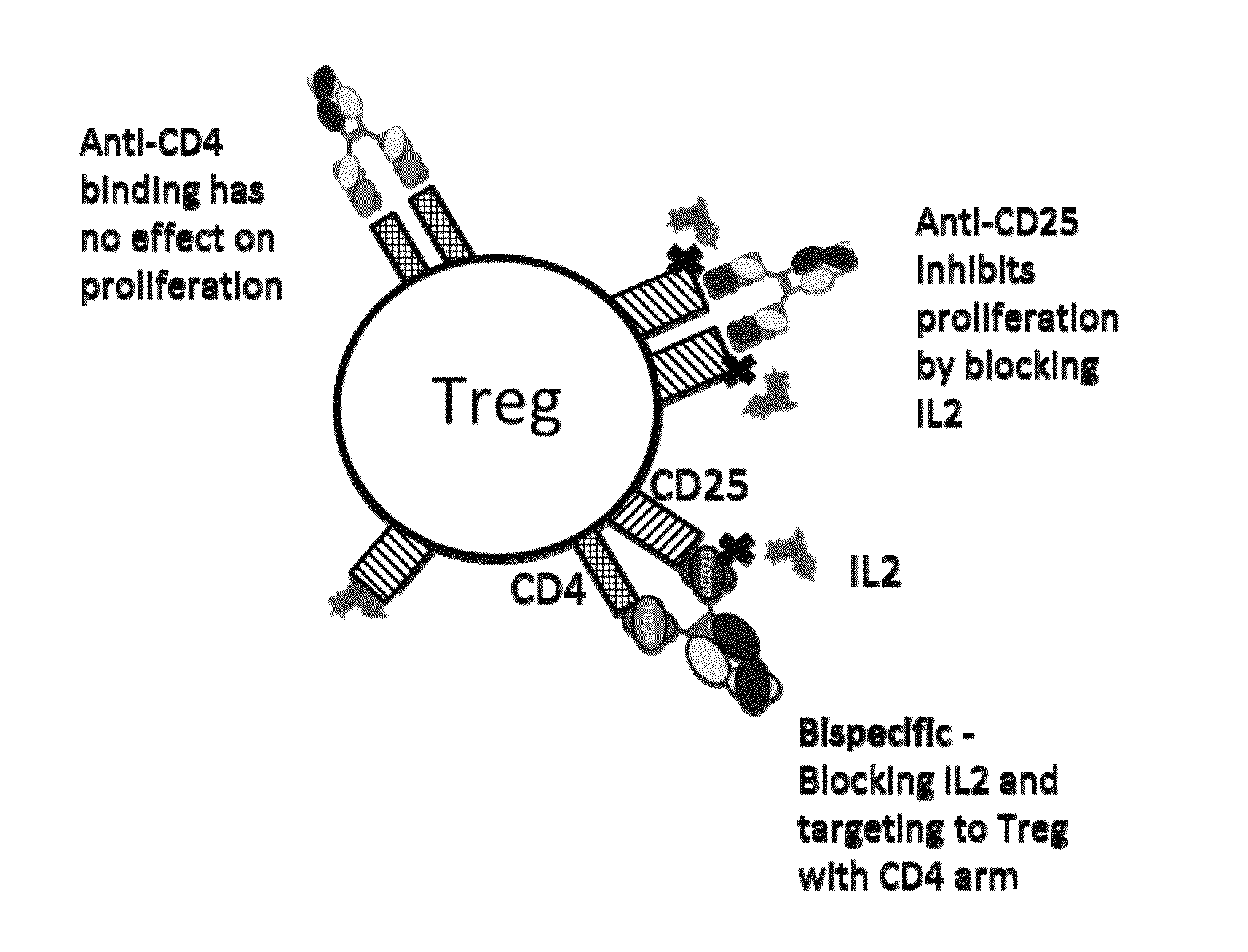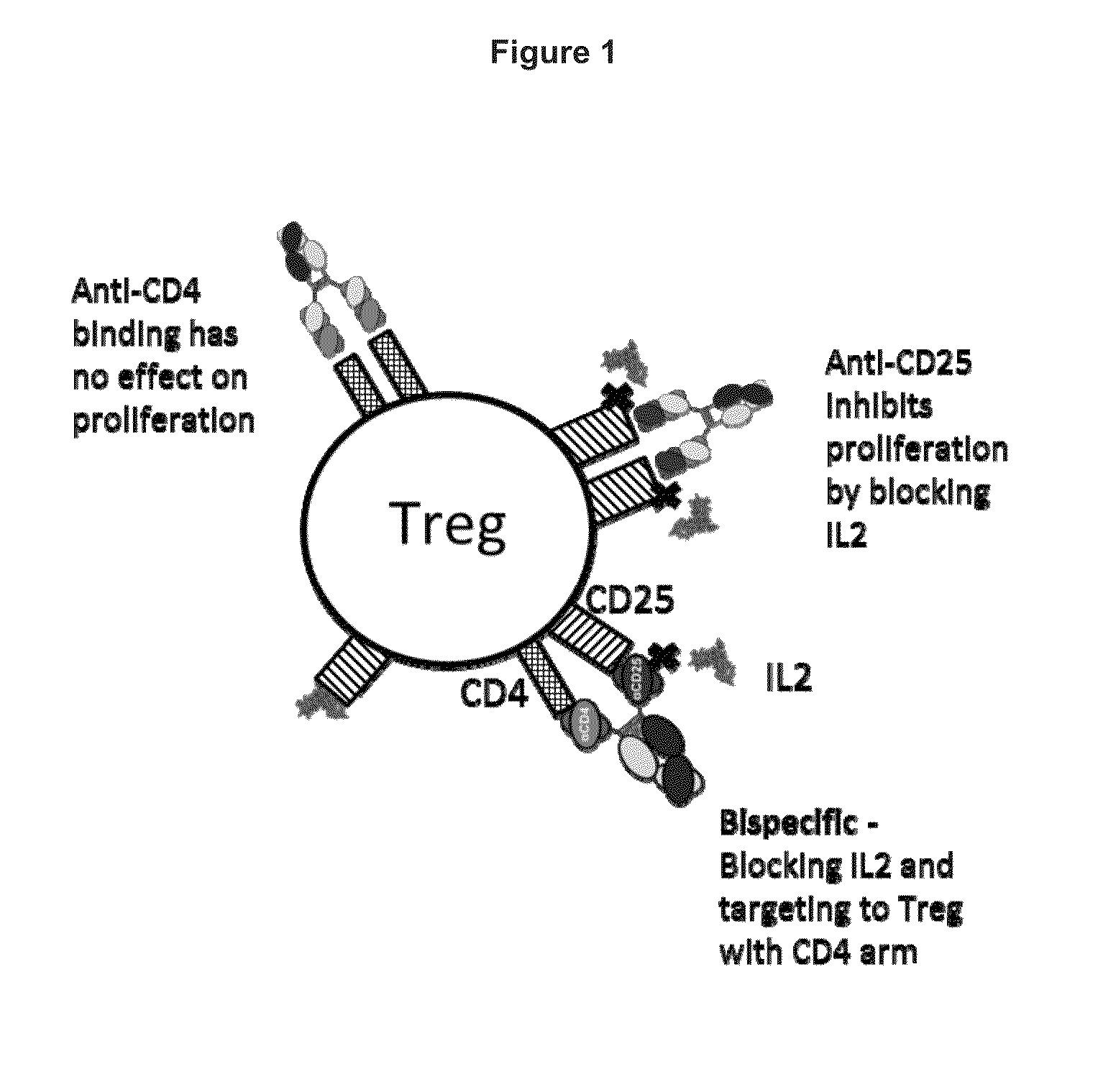Targeting regulatory t cells with heterodimeric proteins
a heterodimer protein and t cell technology, applied in the direction of fused cells, drug compositions, immunological disorders, etc., can solve the problems of affecting the balance of t cells, frustrating efforts to deplete, and single treg-specific surface markers are difficult to find, so as to suppress or induce cytotoxic t cells, little or no impact on other t cells, and little or no impa
- Summary
- Abstract
- Description
- Claims
- Application Information
AI Technical Summary
Benefits of technology
Problems solved by technology
Method used
Image
Examples
example 1
Constructing Anti-CD4×Anti-CD25 Bispecific Antibodies
[0425]A concept for suppressing Treg cells with anti-CD4×anti-CD25 bispecifics while not affecting other T cell types is shown schematically in FIG. 1.
[0426]The ability of various anti-CD25 heavy chains to pair with anti-CD4 light chains and anti-CD4 heavy chains to pair with anti-CD25 light chains in order to create a “common light-chain” anti-CD4×CD25 bispecific antibody was evaluated. Desired gene segments were synthesized by Blue Heron Biotechnologies (Bothell, Wash.) from synthetic oligonucleotides and PCR products by automated gene synthesis. Antibody constructs in the pTT5 vector were expressed in 293E cells and purified by standard Protein A, followed by IEX chromatography in order to isolate the desired heterodimeric bispecific. Biacore was used to examine binding of the various pairs to both CD4 and CD25 and the results tabulated (FIG. 2). 100 nM of each variant was immobilized on a Protein A chip for 1 min, followed by ...
example 2
Suppression of Regulatory T Cells with Anti-CD4×Anti-CD25 Bispecific Antibodies
[0429]Treg cells were generated in vitro using the following method. CD4+ enriched T cells (isolated using the EasySep™ Human CD4+ T Cell Enrichment Kit from Stemcell Technologies) from PBMC were incubated with anti-CD3 / anti-CD28 beads (20 μl beads in 100 μl volume, or 4:1 beads to cell ratio using Dynabeads® Regulatory CD4+CD25+ T Cell Kit) with 500 U / mL of IL2 in the presence of 0.1 μg / ml rapamycin for a week. Cells were replaced with new culture with anti-CD3 (OKT3, eBiosciences) plate bound at 0.5 μg / mL and soluble 0.5 μg / mL anti-CD28 (clone 28.2, eBiosciences) with 100 U / mL of IL2 and 0.1 μg / mL rapamycin.
[0430]Proliferation of Treg cells was assayed using CFSE cell proliferation assay or Alamar Blue cell viability assays in the presence of bispecific or control antibodies with 15 U / mL IL2. Results are shown in FIG. 5, FIG. 7, FIG. 12, FIG. 13, and FIG. 15. Anti-CD4×Anti-CD25 bispecifics 11209 and 121...
example 3
Effect of Altering Antigen Binding Affinity of Anti-CD4×Anti-CD25 Bispecific Antibodies
[0431]Variant bispecific antibodies and one-armed antibody controls were constructed in which the CD25 binding affinity was altered. The Anti-TAC_H1.8L1 Fv (in 13531 and 13532) has 6-fold increased affinity for CD25. Conversely, the Anti-TAC_H1L1.12 Fv (in 13533 and 13534) has 17-fold lower CD25 affinity. These variants were assessed in cell proliferation assays (FIG. 15). A clear correlation between CD25 affinity and potency can be seen. 13531 with increased CD25 affinity has the strongest inhibition of cell proliferation, while lower affinity resulted in a reduced effect on cell proliferation. A similar pattern is also expected if CD4 affinity was altered. However, increasing the affinity for CD4 may result in even greater potency on Tregs due to its lower expression level compared to CD25. This can be shown by lower binding of anti-CD4 mAbs on Tregs compared to anti-CD25 mAbs (shown in FIG. 8)....
PUM
| Property | Measurement | Unit |
|---|---|---|
| Volume | aaaaa | aaaaa |
| Cytotoxicity | aaaaa | aaaaa |
Abstract
Description
Claims
Application Information
 Login to View More
Login to View More - R&D
- Intellectual Property
- Life Sciences
- Materials
- Tech Scout
- Unparalleled Data Quality
- Higher Quality Content
- 60% Fewer Hallucinations
Browse by: Latest US Patents, China's latest patents, Technical Efficacy Thesaurus, Application Domain, Technology Topic, Popular Technical Reports.
© 2025 PatSnap. All rights reserved.Legal|Privacy policy|Modern Slavery Act Transparency Statement|Sitemap|About US| Contact US: help@patsnap.com



